Mary Anne Yarde's Blog: The Coffee Pot Book Club , page 202
July 5, 2017
Author’s Inspiration ~Mary Ann Bernal #HistFic @britonanddane
It is with the greatest of pleasure that I welcome Historical Fiction author, Mary Ann Bernal, on to the blog to day. Ann is going to share with us the inspirations behind her latest book...
The Briton and the Dane: Timeline

Dr. Gwyneth Franger, a renowned expert in early medieval England, is set upon learning the truth about the death of Lord Erik, the last descendant of the powerful House of Wareham. Her quest becomes an obsession, a condition that began with the discovery of a portrait of the tall and valiant warrior with which she forms an extraordinary and inexplicable bond.
Digesting troves of mildewed scrolls and source documentation only enhances her belief that Lord Erik was brutally assassinated by a cabal of traitors in the pay of William the Bastard, shortly before the onslaught of the Norman Invasion.
On an archeological dig in Southern England, her team unearths an Anglo-Saxon fortress, a vast citadel built during the reign of Alfred the Great, which she believes was Lord Erik’s stronghold. In the midst of her excitement, she is awakened one night from her slumbers by a disconcerting anomaly emerging from the site.
Dr. Franger finds herself transported back to the Dark Ages and at the side of the noble Lord Erik who commands an army of elite Saxon warriors, a swift and mobile force able to deploy quickly throughout the kingdom to ward off invaders.
Witnessing the unrest firsthand, Gwyneth senses that her instincts had been right all along, and she is determined to learn the identities of the treacherous blackguards hiding in the shadows, villains who may well be posing as Lord Erik’s friends and counselors.
Will Gwyneth stop the assassins? Is she strong enough to walk away and watch her beloved Erik die? Or will she intervene, change the course of history and wipe out an entire timeline to save the man she loves with all her heart?
Author's Inspiration
I have always been fascinated with the days of old, when Vikings terrorized the countryside and knights defended the realm after having seen such Hollywood blockbusters as The Vikings, Knights of the Round Table, and Ivanhoe, to name but a few.
Becoming obsessed with King Alfred the Great and the Great Viking Army, The Briton and the Dane trilogy brings to life my view of how life might have been during such violent times. My characters exhibit every emotion known to mankind, behaving just like us, but in a different age. My imagination went wild with the numerous “what ifs”, and what started out as My Erik the Viking novel exploded into a trilogy; so many characters demanding their story be told.
The Briton and the Dane: Timeline was born out of guilt, that’s right. The original Erik and Gwyneth storyline was overshadowed by the supporting cast, which, essentially, took my main characters out of the limelight.
Those old enough might remember the old Erik the Viking cigar commercials – It was this vision that kept alive my proposed novel until I had time to set cursor to blank screen.
With this vision in mind, I decided to give Erik and Gwyneth another chance at having their story told, even though they are not the original Erik and Gwyneth of the first novel.
My decision to have a “modern” Gwyneth going back in time was based upon the “what if” premise, what if a decision changed the course of history?
As in real life, nothing is ever easy, as Gwyneth quickly discovers. Seeing the beauty of the world before technological advances has to be mind boggling and humbling. Could a modern person return to an ancient time and not corrupt its inhabitants? One could argue mankind doesn’t need extra help to become corrupt!
In my opinion, it is easier for a modern person to travel back in time then vice versa. It is also much easier to change history when one allows emotions to dictate one’s actions. And that is Gwyneth’s dilemma. Who will win? The heart or the brain?
My thoughts return to Elizabeth I and her relationship with Robert Dudley, and how his wife’s mysterious death affected their liaison. If Elizabeth ruled with her heart, like the behavior of her nemesis, Mary Stuart, Queen of Scots, and married Robert Dudley, she could have lost her crown over the scandal. Putting the nation first, Elizabeth did not allow her emotions to dictate her behavior, and temporarily removed Robert Dudley from serving at Court.
On the other hand, Mary Stuart, Queen of Scots, scandalous behavior with Lord Darnley and the Earl of Bothwell cost her the Scottish throne.
These women inspired my interpretation of events surrounding Gwyneth’s behavior throughout the novel.
Being an incurable romantic, I would like to think that love conquers all, but, alas, history contradicts happy endings. But that’s okay, as long as one is truthful to one’s passion, the ending can be whatever one’s heart or brain desires.
Links to purchase
Amazon US
Amazon UK
Smashwords
Barnes & Noble
www.maryannbernal.com
www.whisperinglegendspress.com
About the author

Mary Ann Bernal is a family oriented, community activist participating in programs supporting the United States military. A guest on The Morning Blend television show hosted by KMTV, the CBS affiliate in Omaha, Mary Ann was also interviewed by the Omaha World-Herald for her achievements.
All of Mary Ann’s novels and short story collections are dedicated to fallen military heroes who gave their lives defending our freedom. A prolific writer originally hailing from New York, Mary Ann now resides in Omaha and has traveled for pleasure and research to the United Kingdom, Ireland, Italy and Greece.
Published on July 05, 2017 00:00
July 3, 2017
Guest Post ~ A Scottish King Arthur? #Arthurian #Legends #kingarthur @jaortonwriter
I am handing the blog over today, to fellow Arthurian fantasy author, Justin A Orton. Justin is going to put forward the case for a Scottish King Arthur. So over to you, Justin…
 I’ve been asked many times where the concept of a Scottish King Arthur arose.Well this is not a new concept. The Clive Owen movie “King Arthur” is set north of Hadrian’s wall and most of the action takes place in the Scottish borderlands. Others have also explored the “Scottish” Arthur, most notably the historian David F. Carroll in his book “Arturius – A Quest for Camelot”. Much of my research mirrors his and I would encourage those seeking further details to read his book.As a child, I was obsessed with the Arthurian Legend, and yes – I spent far too many childhood days searching rocks for hidden swords! Alas I’m not king yet!From the age of ten, Scotland had become our vacation destination of choice and before long I fell totally in love with the rugged beauty of this land, its people, its music and its history. Robert the Bruce supplanted Arthur as my favorite hero king and it was while researching his history that I stumbled across Arthur again.By this time I had come to believe that “King Arthur” never truly existed, and was more a composite figure whose fame had grown with hand me down stories. It seemed every location in England wanted to claim some link to the Arthur legend, and while each offered a tantalizing thread to the story, Scotland is the only location I’ve found where not just Arthur, but many of the places, and characters from the legend can be found in the same geographical region, and historical period.Only in Scotland can a case can be made for the existence of:· Arthur· Camelot· The Round Table· The battle of Camlann· Avalon· Morgan· Guenevere· Merlin
I’ve been asked many times where the concept of a Scottish King Arthur arose.Well this is not a new concept. The Clive Owen movie “King Arthur” is set north of Hadrian’s wall and most of the action takes place in the Scottish borderlands. Others have also explored the “Scottish” Arthur, most notably the historian David F. Carroll in his book “Arturius – A Quest for Camelot”. Much of my research mirrors his and I would encourage those seeking further details to read his book.As a child, I was obsessed with the Arthurian Legend, and yes – I spent far too many childhood days searching rocks for hidden swords! Alas I’m not king yet!From the age of ten, Scotland had become our vacation destination of choice and before long I fell totally in love with the rugged beauty of this land, its people, its music and its history. Robert the Bruce supplanted Arthur as my favorite hero king and it was while researching his history that I stumbled across Arthur again.By this time I had come to believe that “King Arthur” never truly existed, and was more a composite figure whose fame had grown with hand me down stories. It seemed every location in England wanted to claim some link to the Arthur legend, and while each offered a tantalizing thread to the story, Scotland is the only location I’ve found where not just Arthur, but many of the places, and characters from the legend can be found in the same geographical region, and historical period.Only in Scotland can a case can be made for the existence of:· Arthur· Camelot· The Round Table· The battle of Camlann· Avalon· Morgan· Guenevere· MerlinArthur
So who is this real Arthur of Scotland? Let’s avoid poems, myths and other unreliable works, and focus on historical record. To do this we must forget any reference to the word Arthur. The use of the ‘h’ was not common until the 12thcentury, which is when Geoffrey of Monmouth penned his “History of the Kings of Britain”. Most of the legends we have come to accept stem from this somewhat “fanciful” accounting. To coin a phrase from another childhood hero – Indiana Jones – “We’re digging in the wrong place!”.
Sixth century writing was predominantly Latin and the name Arthur, or Artur would have been recorded as Arturius. As soon as we drop the “h” the pieces of the puzzle start to fit for in 6th century Scotland we find record of one of the greatest war leaders of the time. Arturius – son of Aidan MacGabran, King of Dalriada.

Arturius governed the Scottish region of Mannan, located between the two roman walls – Hadrian’s to the south, and the Antonine wall to the north. Rome’s influence in this region had been limited to a frontier outpost. It was a troublesome military district, difficult to control and with little value to the empire. They abandoned this northern frontier falling back to the stronger defensive line of Hadrian’s wall. It is highly likely that the people of this region had trained, fought and served in the battle-hardened legions of Rome, as portrayed in the Clive Owen movie.
Camelot
At the sound of the word we imagine grand castles more akin to Disney, or the mighty fortifications of the Norman period that came hundreds of years AFTER Arthur. Many cities over the years have been tagged as built on the bones of Camelot - but there has been no historical record of such a fortress-city. However, in Scotland - there is documented evidence of a fort known to the Romans as Ad Vallum, but to the Britons of the time as Camelon - later corrupted to Camelot. This fortress was an impressive structure and guarded not only the central region of Scotland but also the strategic crossing point of the River Carron. The small town of Camelon remains to this day, 1.5 miles west of Falkirk, and yes you guessed it – this fortress was the base of operations for none other than Prince Arturius – war leader of the north.

The Round Table
Conditioned by movies, novels and epic poems we all think of a gigantic round table within the halls of Camelot, around which Arthur and his knights held council. Of course, no true table has been discovered, and were a round table to be unearthed it would be incredibly difficult to prove it was that of legend - unless perhaps it were found at Camelon! Well, interestingly enough there is, not far from Camelon, beneath the towering buttresses of Stirling castle, a mound known as the King’s Knot. It is known for certain that this mound predates Stirling castle, and there is a poem that actually names this mound the “Round Tabill.” The poem admittedly was written in 1370 and tells of the flight of King Edward after his crushing defeat at Bannockburn by King Robert the Bruce. “An besouth the Castill went they thone, Rychte by the Round Tabill away…”It is conceivable this place was a neutral meeting place for “Arturius” and the vassal kings of the North.

In my novel “To Raise a King” I use this location for Arthur’s Round Table. I could easily picture Arturius and the kings of the region gathered at the top of the mound, with various chieftains and generals placed on a lower tier, while their guards attendants and retinue gathered on the flats around.
Camlann
In legend King Arthur died in the battle of Camlann, fighting the Picts, who were led by Mordred son of King Lot. Again, there is no reliable historical record of such a battle in England or Wales, yet recorded in the Annals of Ulster in the year 582AD a major battle was fought in Mannan near the river Allan – known as the Crooked Allan. Crooked in Gaelic translates to “Cam,” and thus the river was known as Camallan. Our factual Arturius, war leader of the North, is recorded to have died here - fighting none other than the Picts! This is conclusive stuff, but let’s throw a little supposition into the mix. In all probability, the Pictish forces would have been led by the son, or sons, of the Pictish king. At the time of Camallan, this King was Cannelat. “Canne” is actually a Celtic prefix meaning head or chief. If one drops the “Canne”, you are left with the name Lat. Could king Lot of legend, actually be Chief Lat of history?
Avalon
In the legend of Arthur, our heroic king, mortally wounded, is taken to the island of Avalon by his sister Morgan. Yet again no historical record exists for a place named Avalon. But - I know I’m getting predictable here - records show the land immediately adjacent to the battlefield of Camallan was originally swamp. In fact an island existed here formed by the river Allan to the east, the river Forth to the south, and the river Teith to the west with the intervening land comprising water-filled swamps. Being on the banks of the Allan this land would have been known as Av Allan – which translates to “On Allan”. Say “Av Allan” to yourself a few times - sounds remarkably like Avalon right? You can almost picture the loyal soldiers carrying their fallen leader to a place of safety and this island would surely have been it.
Morgan
One could argue that all the above historical records are mere coincidence, but it becomes harder to dismiss the facts when you consider that King Aidan MacGabran - the father of Arturius - also had a daughter named Mergein, meaning sea birth. Mergein of course is later corrupted to Morgain, and by the 12thcentury had morphed into Morgan.
Guenevere
There is no record of Guenever (Gwenevere) until Geoffrey of Monmouth’s fanciful history. By the time of its writing (600 years after the death of Arturius) the language had changed, and spellings had changed. However, it is interesting to discover that the wife of Arturius – rumored to have been taken by the Picts - was named Anora. In the time of Geoffrey of Monmouth it was not uncommon to prefix a name with Guan, later written as Gwen (literally meaning white, representing fair or pure). Arthur’s queen would thus have been recorded as Fair Anora, or Guan-anora - phonetically Gwenanora. It is possible that this was later corrupted into Gwenevere. I admit this is far from conclusive, but it does add another link all be it tenuous between our historical Arturius of the North and the legend we’ve come to love.
Merlin
And so finally to Merlin. It’s hard not to get a little excited when you hear the name Merlin. What you may not know is that a true figure of history existed with the name Merlin or Myrddin. The Annals of Wales contains an entry showing that Myrddin was allied with a pagan prince who was defeated in battle in 573AD at the Battle of Arderydd - just north of Carlisle. Known as a druid, or bard, he fled the field of battle and lived in the wooded areas of Celyddon between the two Roman walls - the Antonine and Hadrians – in the exact vicinity of Camelon! This Merlin came under the protection of one of the kings of the north - King Ryderrch. Given Arturius was known to be war leader of these northern kings, then it is extremely likely that Arturius and Merlin were known to each other.My novel “To Raise a King” is built around these characters and locations. Legends claim that Arthur never died, but merely fell into a magical sleep to awaken in his countries time of need. David Carroll makes an interesting link to the fact that William Wallace - another larger than life hero - did in fact rise, from this very same region to serve his country. I’ve taken a slightly different path but for that you’ll need to read “To Raise a King” and the forthcoming sequel “To Save a Queen”.
Thank you so much Justin, for such an informative post! If you would like to check out Justin’s debut novel, To Raise A King, then scroll down…
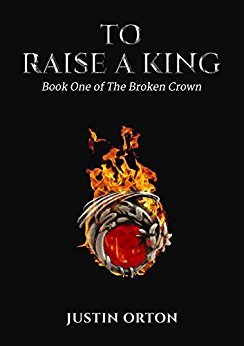
When Matt escapes a Scottish boys' home to search for his parents, he instead finds himself fleeing for his life. Cast back in time to the brutality of 6th-century Scotland, he is sent on a dangerous quest - a race to recover the missing fragments of a broken crown and save two worlds from certain destruction.Love, betrayal and murder follow Matt as he struggles against a backdrop of powerful magic and political tension that soon erupts into open war. Matt's faith in himself, and his trust in his newfound friends will be put to the ultimate test as he fights to Raise a King.
Links for purchase
Amazon US
Amazon UK
About the author
I spend most days delving into the world of computer code and unraveling programming mysteries for many major corporations, but my true passion is fictional writing.
My work is always supervised by Oliver (my cat), who’s four-legged contributions can often be found in both my coding and writing (all spelnig errors r stritcly his!).
I was born and raised in England, but now live with my beautiful wife Lisa in Florida (famous for its theme parks, beaches, the occasional hurricane, and a certain mouse).
My hobbies include: reading, movies, history, travel (I want to see mountains again Gandalf – mountains!), and exploring the latest gadgets and gizmos.
I’m rather fond of single malt scotch and it’s not uncommon to find me of an evening, sipping on a fine dram, while pondering how to get a character out of the very awkward situation I recently put them in!
Published on July 03, 2017 23:00
#Bookreview ~ The Indigo Rebels #HistFic #WW2 @EllieMidwood
The Indigo Rebels ByEllie Midwood
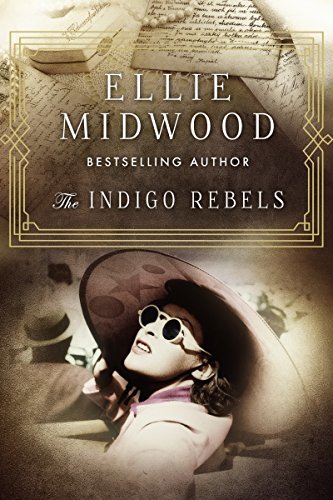
France, 1940
The German army has marched into Paris. Three siblings, three very different people leading very different lives, find themselves face to face with new occupants of their city, and none of them can guess what the occupation has in store for them, and how it will change their lives once and for all.
Giselle Legrand, a renowned novelist and a socialite, encounters an unannounced guest in her apartment – a newly arrived chief of the Gestapo, Sturmbannführer Dr. Karl Wünsche, who is intended to billet there and who soon starts making rather unwelcome changes in Giselle’s lifestyle. Strong-willed and defiant, Giselle gets involved with one of the first Resistance cells, refusing to submit to the newly established authority despite the developing relationship between the two.
Kamille Blanchard, a new widow of the war left alone with a small daughter, is dreading the approaching army. However, she never expected that she could find love in the arms of an officer, who appears at her door as soon as the German army marches in. But will Kamille be able to trust a former enemy when he has to choose between his feelings and the duty for his country?
Marcel Legrand, a former history student and a deserter, fearing the capture by the Germans has no other choice than ask for the help from the ones he used to fear and avoid – the mysterious communists, who call for an uprising and freeing their country from the Nazi plague.
Soon, the fates of all three siblings will become intertwined in a dangerous knot, all of them, fighting for the same goal: a liberated France.
What did I think of the Book?
In times of War and Peace.
France is under occupation. Giselle Legrand has to share her house with the Chief of the Gestapo. At first, Dr Karl Wünsche intrigues her, but soon her eyes are opened and she sees the ruthless monster that he truly is. Appalled by his behaviour towards her fellow countryman, Giselle joins the Resistance determined to do her part to rid her country of these Foreign invaders.
I am a big fan of Ellie Midwood's work, and I was looking forward to her latest book. The Indigo Rebels didn't disappoint. It was exactly the kind of story I expect from Ms Midwood.
Filled with historical detail and with a compelling plot, The Indigo Rebels was a real page-turner. I simply could not put it down.
I adored the characterisation of Giselle. Giselle is a feisty, independent woman who, despite appearances, is determined to do something to free France. She is subjected to scorn from her fellow countryman who believes that she has sold her soul to the enemy, little do they know where her loyalties really lie.
I also loved the characterisation of Kamille. The complete opposite of her sister, Kamille, never expected to find love in the arms of the enemy, but Jochen is like no man she has ever met and her young daughter adores him. I thought it was a wonderful contrast between Giselle's relationship with the feared Chief of the Gestapo, Karl. Jochen is loving and kind. He is as appalled as Kamille to the German atrocities that he is witnessing.
I really enjoyed this book and I think it will be one that I come back to again and again. If you are looking for quality historical fiction set in World War One, then you cannot go far wrong with The Indigo Rebels.
I Highly Recommend.
Links for Purchase
Amazon US
Amazon UK
About the author

Ellie Midwood is an award-winning, best-selling historical fiction writer. She's a health obsessed yoga enthusiast, a neat freak, an adventurer, Nazi Germany history expert, polyglot, philosopher, a proud Jew and a doggie mama.
Ellie lives in New York with her fiancé and their Chihuahua named Shark Bait.
Published on July 03, 2017 00:38
July 2, 2017
#Bookreview ~ Flock, The Gathering of The Damned #HistFic #ASMSG @AuthoJana
Flock, The Gathering of The Damned (The Flock Trilogy Book 3) ByJana Petken

Flock, The Gathering of The Damned, from the bestselling and multi-award-winning author of The Errant Flock, The Guardian of Secrets, Dark Shadows: Mercy Carver, and Swearing Allegiance.
The Sagrat militiamen suspend their hunt for Alejandro and return to Valencia to discover that they have become the prey.
When Rafael Perato is abducted at the Inquisitor’s funeral, he finds himself facing a new and dangerous enemy. What his captor wants with him is unclear, but as the days turn to weeks Rafael is plunged deeper and deeper into a web of deceit and betrayal.
David Sanz is marked for death after he uncovers a deadly secret and must choose between his duty to find Rafael Perato and his need to evade capture.
What did I think of the Book?
Conspiracies and intrigue in 16th Century Spain...
This is one of my most hotly-anticipated books of the year. Rich in historical detail with a story line that is simply unputadownable, Flock, The Gathering of the Damned, is an example of historical fiction at its very best.
Book 3 in The Flock Trilogy picks up where Book 2 left off, and I found myself immediately thrown back in the thick of the action.
This isn't a standalone book, you do need to read the other two books to appreciate how wonderfully compelling this story is. Set in 16th century Spain, during the Spanish Inquisition, Flock, The Gathering of the Damned, is full of conspiracies and plots. No one is safe, and everyone has their secrets.
Jana Petken is not only a master storyteller, but her attention to the historical detail of the era has to be commended. It is very obvious that Ms Petken has spent many hours researching this period and this comes across in her writing.
As before, I found the characters very well drawn. It was great to meet up with old friends, such as David, but Ms Petken has brought new characters into the story, and they slipped in as if they had always been there.
Reading this book was effortless, it was like watching a movie, and I didn't notice the time pass by while I was reading.
I cannot recommend this series, or this book, enough. Fabulous, rich storytelling that will leave you wanting more.
I Highly Recommend.
Links for Purchase
Amazon US
Amazon UK
About the author

Jana Petken is a multi award winning, bestselling historical fiction novelist. She served in the British Royal Navy, was a bodyguard, and a member of British Airways cabin crew.She turned to writing after an accident on board an aircraft, and has become critically acclaimed as a gritty, hard hitting author who produces bold, colourful characters and riveting storylines.Useful Links Website
Published on July 02, 2017 23:00
June 29, 2017
#newrelease ~ Quest of a Warrior #Romance @m_morganauthor
Links for Purchase
Amazon US Amazon UK
About the author
 Scottish paranormal romance author, Mary Morgan resides in Northern California, with her own knight in shining armor. However, during her travels to Scotland, England, and Ireland, she left a part of her soul in one of these countries and vows to return.
Scottish paranormal romance author, Mary Morgan resides in Northern California, with her own knight in shining armor. However, during her travels to Scotland, England, and Ireland, she left a part of her soul in one of these countries and vows to return. Mary's passion for books started at an early age along with an overactive imagination. She spent far too much time daydreaming and was told quite often to remove her head from the clouds. It wasn't until the closure of Borders Books where Mary worked that she found her true calling--writing romance. Now, the worlds she created in her mind are coming to life within her stories.
Published on June 29, 2017 16:00
June 28, 2017
The Land of Merlin ~ Merlin's Cave #FolkloreThursday #Arthurian #Britain #legend
We tend to think of folklore as stories that were told a long time ago — but are we right in this assumption?
The Great sorcerer, Merlin.
Last week I took a look at Geoffrey of Monmouth’s interpretation of Merlin. This week, I am going to stick with Merlin, but instead of Monmouth I am going to take a look at another one of the Great Arthurian Writers. I will also try to answer the question I just posed.
"Wave after wave, each mightier than the last,Till last, a ninth one, gathering half the deepAnd full of voices, slowly rose and plungedRoaring, and all the wave was in a flame:And down the wave and in the flame was borneA naked babe, and rode to Merlin’s feet,Who stoopt and caught the babe, and cried "The King!Here is an heir for Uther!"
The above quote was taken from Tennyson’s Idylls of the King and the place Tennyson was referring to was none other than Merlin’s Cave in Cornwall. The cave itself sits under Tintagel Castle, and if you have the slightest interest in Arthur, then I am sure you have heard of Tintagel. If you ever get the chance to visit Tintagel, then do. It is a stunning location, well worth checking out.

Who was Lord Tennyson?
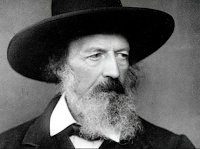 Alfred Tennyson, 1st Baron Tennyson, (6 August 1809 – 6 October 1892) was the Poet Laureate of Great Britain and Ireland during much of Queen Victoria’s reign. Lord Tennyson was appointed to the position of Poet Laureate in 1850, after the death of William Wordsworth, and he is mostly remembered for his great work — The Charge of the Light Brigade. But I am interested in him because he also published an Arthurian inspired epic poem between 1859 and 1885 and he called it, as I have already said, The Idylls of King.
Alfred Tennyson, 1st Baron Tennyson, (6 August 1809 – 6 October 1892) was the Poet Laureate of Great Britain and Ireland during much of Queen Victoria’s reign. Lord Tennyson was appointed to the position of Poet Laureate in 1850, after the death of William Wordsworth, and he is mostly remembered for his great work — The Charge of the Light Brigade. But I am interested in him because he also published an Arthurian inspired epic poem between 1859 and 1885 and he called it, as I have already said, The Idylls of King.Now anyone who writes about Arthur, myself included, draws on the work of the Great Arthurian Poets, and Tennyson was no different. But his poem was so epic that he split it into 12 parts, and each part dealt with a different aspect of the Arthurian tale — however, he gave his stories a slight Victorian twist!
Tintagel Castle and Merlin’s Cave.

Geoffrey of Monmouth had already given us Tintagel Castle as the birthplace of Arthur. Tennyson took this one step further, and I can understand why he did. There is a cave under Tintagel Castle, and this cave was begging to be included in the tale. The cave in question fills up with water at every high tide, and it is easy enough to imagine Merlin approaching the cave with a shining staff in his hand, lighting his way. If Merlin were to have a cave, then this would be it. This unknown cave became a tourist attraction that suddenly had a long association with Arthurian legend — it was just that no one knew about it until Tennyson told us!

Another Arthurian location...
I don’t know about you, but I love checking out film locations. I am lucky enough that I live very near some Poldark film locations. I have also travelled around Scotland checking out the Outlander film locations. Now I am sure you would not disagree with me when I say that neither Poldark or Outlander scream folklore. But when we put the same principles into Arthur’s story then there are some startling similarities because, let’s be honest, if you are going to visit an Arthurian location, it isn’t the same as spending the day at, I don’t know, Hampton Court. You are instead visiting book locations, folklore locations.

However, saying that, visiting Arthurian book locations doesn’t feel the same, as visiting the locations of Poldark, Outlander or even Game of Thrones for that matter, because we recognise them as stories, but when it comes to Arthur, we don’t do that. The folklore is so engrained into our culture that we just kind of accept it as maybe not fact, but something very close. And the reason for this is simply because Geoffrey of Monmouth’s great work in the 12th Century was a must read. A factual, must read. And that is where the problem lies with Arthurian folklore. For centuries we were told these stories were true and somewhere ingrained deep down inside us is the belief that they are. Of course, over the centuries there are plenty of people who have exploited the Arthurian story — the monks of Glastonbury Abbey being one of them. But just think on this, a thousand years ago the people of Britain were making pilgrimages — we would probably call it a holiday, or a day out — to these sites that were associated with Arthur and we are still doing it, after all this time. Isn’t that incredible? Arthur is still drawing in the crowds, and I believe that he will continue to draw in the crowds long after we have forgotten all about Poldark and Outlander and even, dare I say it, Jon Snow. And that, my friends, is the power of folklore. It is not the same as a book, it isn’t the same as factual history. It evolves, and we accept it. Suddenly Tennyson’s version of events seems as old as time. Merlin always had a cave...didn’t he? It is humbling when you think about it.
If you fancy finding out what happened after the death of King Arthur, then why not check out my historical fantasy series — The Du Lac Chronicles...
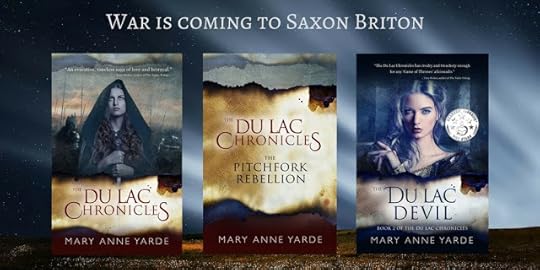 Amazon US
Amazon USAmazon UK
Read for free with

Published on June 28, 2017 23:00
Author’s Inspiration ~ Judith Arnopp #Historical #Histfic @JudithArnopp
Please give a warm Coffee Pot welcome to Historical Fiction author, Judith Arnopp. Today, Judith is going to share with us her inspirations behind her latest series…
The Beaufort Chronicles
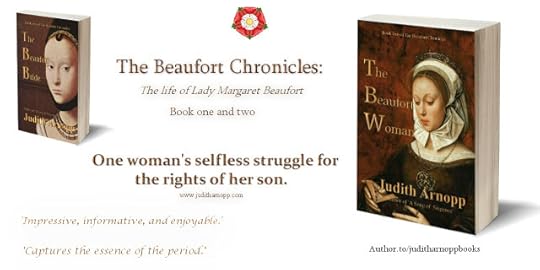
The Beaufort Bride - As King Henry VI slips into insanity and the realm of England teeters on the brink of civil war, a child is married to the mad king’s brother. Edmund Tudor, Earl of Richmond, takes his child bride into Wales where she discovers a land of strife and strangers.
At Caldicot Castle and Lamphey Palace, Margaret Beaufort must put aside childhood to acquire the dignity of a Countess and despite her tender years produce Richmond with a son and heir.
While Edmund battles to restore the king’s peace, Margaret quietly supports his quest; but it is a quest fraught with danger.
As the friction between York and Lancaster intensifies Margaret, now fourteen, is widowed and turns for protection to her brother-in-law, Jasper Tudor. Two months later at Jasper’s stronghold in Pembroke, Margaret gives birth to a son whom she names Henry, after her cousin the king.
Margaret’s story continues in The Beaufort Woman
As the struggle between York and Lancaster continues Margaret, now married to Henry Stafford, fights for admittance to the court of the victorious Edward IV of York and his unpopular queen, Elizabeth Woodville.
The old Lancastrian king and his heir are dead, leaving only Margaret’s son, the exiled Henry Tudor, with a tenuous claim to the throne. York’s hold on England is strong and his royal nursery replete, with two small princes securing their line. But Edward and Elizabeth’s magnificent court hides a dark secret, a deception that threatens the security of the English throne … and all who lust after it.
In 1483, with the untimely death of the King, Margaret finds herself at the heart of chain of events that threaten the supremacy of York, and will change England forever.
Author’s Inspiration
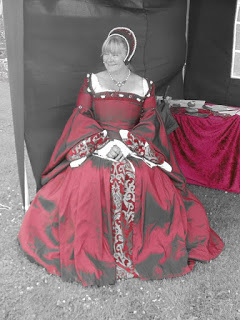 I can scarcely believe I am on my ninth historical fiction book now. My first,
Peaceweaver
, was published in 2009 and many things about my writing have altered since then. My inspiration however has remained the same.
I can scarcely believe I am on my ninth historical fiction book now. My first,
Peaceweaver
, was published in 2009 and many things about my writing have altered since then. My inspiration however has remained the same. I’ve read historical fiction all my life and when I began to think about a writing career I didn’t consider any other genre. I have always been fascinated not only with the fashions and social considerations of the past but with the people, particularly the women. Females had it tough – well, everybody had it tough but men were at least allowed their place in history. The motivations, concerns and actions of women, not highly regarded by the male chroniclers, were largely underrepresented. I like to provide these women, silenced by history, with a voice. I write from a female point of view, using fiction to fill the void but I never forget it is fiction, even if it is heavily based on research.
The wives of Henry VIII are often dismissed as ‘boring’ but that is so far from the truth. Each one of Henry’s queens is fascinating, and there is something to admire in all of them. Catherine of Aragon refused to bow to Henry’s desire for a divorce was exiled from court, living in relative penury for the sake of her daughter’s position. Anne Boleyn, dismissed by history as a scheming home wrecker was a strong woman who did much for the new religion and possessed a fierce and challenging intelligence. Henry’s third wife, Jane Seymour, was queen for such a short time that there is little in the record to reveal her real character or motivation. Some historians dismiss her as the tool of ambitious brothers, while some claim she actively sought Henry’s favour with an eye to the main prize. Whichever way you view her, ultimately she sacrificed her life to provide Henry with his deepest desire – a son and heir to secure the Tudor line.
Anne of Cleves, faced with the shame of rejection by the fastidious king ultimately emerged best of all. Henry endowed her with fine residences and she lived a full life, often at court as a good friend of the king. Katherine Howard made mistakes yet, despite her tender years, found the capacity to die bravely on the scaffold. And Katheryn Parr, the last queen, played her role of queen faultlessly, escaping the executioner’s blade by a whisker, only to die tragically shortly after giving birth to Seymour’s daughter.
These inspirational women who had the misfortune to attract the attention of Henry VIII and became entangled in his struggle to secure the Tudor line, are the women who inhabit most of my books.
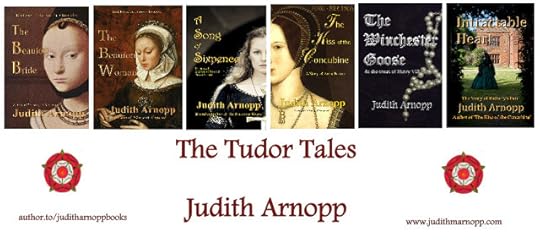
Set at the time of Anne of Cleves and Katherine Howard the narrative of The Winchester Goose passes back and forth between the royal court to the stews of Southwark where prostitute, Joanie Toogood, makes cynical and comical observations on the lives of her betters.
The Kiss of the Concubine is the story of Anne Boleyn – another woman who has been tainted both historically and in fiction. My main inspiration was to allow Anne to tell her side of the story without resorting to the use of witchcraft or to sleeping with her brother! Anne reveals a Henry who is a complex, insecure and often confused man – disappointed in himself and striking out at those who love him best.
Elizabeth of York has, until recently, been neglected in fiction. In A Song of Sixpence I consider the conflicts she, being of York’s line, may have faced as a Tudor queen. I also introduce the mysterious figure of Perkin Warbeck, a challenger to Henry VII’s throne. If Perkin was indeed one of the lost princes, how did Elizabeth overcome the dilemma of choosing between the life of her brother or her son’s future as king of England.These days, women are seldom required to make politic marriages but we are often forced to do things we’d rather not. When Katheryn Parr agreed to wed Henry VIII she sacrificed her own romantic inclination to marry Thomas Seymour but she didn’t go into marriage with the king half-heartedly. She set aside her own plans and fully embraced her role as queen, championing the new learning, standing as regent while Henry fought in France and, unlike her predecessor, behaving in a thoroughly regal and admirable manner. She was also the first English queen to become a published author! Katheryn Parr was perhaps the most surprising of Henry’s queens. All the women I feature are intelligent, resourceful and brave but also flawed, just as we all are. My biggest challenge yet has been Margaret Beaufort. Margaret has been very poorly represented in fiction and the reason for this is quite clear. She was not a pretty woman, but she was pious, resilient and very, very determined. It is not easy to turn a strong, plain woman into a romantic heroine and so, in fiction at least, she has become a harridan, a half-mad zealot. Feminists today rejoice in the few medieval women who stepped from beneath the thumb of masculine authority but Margaret is seldom among them. I wanted to change that because I think a celebration of strong medieval women would be lacking without Margaret; in fact, she should be leading the parade!Margaret emerges as somebody who is imperfect but who seeks perfection, someone whose intentions are honourable but often conflicted. In the beginning, sent as young girl to be the wife of a stranger twice her age, Margaret can have had no concept that she would end her life as the most powerful woman in England.I embraced her journey from girl to woman in The Beaufort Bride and The Beaufort Woman , allowing her to explain her motivation, and describe how she found the strength to fight her cause with very few weapons. I hope that in providing reasons for her actions, and colouring her relationships with emotion, I’ve managed to evoke a little empathy for her too.Currently, I am working on The King’s Mother – the third and final book in the series. Having achieved a status beyond her wildest ambition, Margaret must now try to maintain it amid the rebellion and unrest that undermines her son’s early reign. Margaret is a difficult character to write – sometimes when I try to nudge her along a particular line of narrative she digs in her heels and refuses to move! I have to rethink it and try to negotiate a path that suits us both. When it gets tough I remind myself that the greater the challenge, the greater the reward.So, I appear to have been rambling, I do apologise. The short answer to your question, ‘what is my author inspiration?’ is ‘to give a voice to women in history who have been silenced in the historical record for too long.’Thank you for listening.
Links for Purchase Amazon US Amazon UK
About the authorWhen Judith Arnopp began to write professionally there was no question as to which genre to choose. A lifelong history enthusiast and avid reader, Judith holds an honours degree in English and Creative writing, and a Masters in Medieval Studies, both from the University of Wales, Lampeter. Judith writes both fiction and non-fiction, working full-time from her home overlooking Cardigan Bay in Wales where she crafts novels based in the Medieval and Tudor period. Her main focus is on the perspective of historical women from all roles of life, prostitutes to queens.Her novels include: The Beaufort Bride, The Beaufort Woman (Book One and Two of The Beaufort Chronicles); A Song of Sixpence; Intractable Heart; The Kiss of the Concubine; The Winchester Goose; The Song of Heledd; The Forest Dwellers, and Peaceweaver. She is currently working on Book Three of The Beaufort Chronicles: The King’s Mother. Her non-fiction articles feature in various historical anthologies and magazines. Useful Links Webpage
Author page BlogTwitter Facebook
Published on June 28, 2017 00:00
June 27, 2017
#Bookreview ~ Echo in the Wind by Regan Walker #HistFic #Romance @RegansReview
Echo in the Wind (Donet Trilogy Book 2) ByRegan Walker

England and France 1784
Cast out by his noble father for marrying the woman he loved, Jean Donet took to the sea, becoming a smuggler, delivering French brandy and tea to the south coast of England. When his young wife died, he nearly lost his sanity. In time, he became a pirate and then a privateer, vowing to never again risk his heart.
As Donet’s wealth grew, so grew his fame as a daring ship’s captain, the terror of the English Channel in the American War. When his father and older brother die in a carriage accident in France, Jean becomes the comte de Saintonge, a title he never wanted.
Lady Joanna West cares little for London Society, which considers her its darling. Marriage in the ton is either dull or disastrous. She wants no part of it. To help the poor in Sussex, she joins in their smuggling. Now she is the master of the beach, risking her reputation and her life. One night off the coast of Bognor, Joanna encounters the menacing captain of a smuggling ship, never realizing he is the mysterious comte de Saintonge.
What did I think of the Book?
Love on the High Seas...
Lady Joanna West cannot abide to see the poverty around her, but instead of attending organised charity events by like-minded members of the ton, Joanna embarks on a far more dangerous pursuit to raise some money — she becomes a smuggler.
Her path crosses with the dashing French, Comte de Saintonge. What she doesn't realise is that the Comte is also the captain of one of the smuggling ships that she trades with.
The Comte de Saintonge, appears to be fearless, but that is not so. He fears to fall in love again. Can Lady Joanna help him conquer this fear?
Oh, what is not to like about this book? Set in the year 1784, Regan Walker transports her readers back to pre-revolution France in this most wonderful tale of love, honour and smuggling!
Echo in the Wind grabbed me from the very first page and did not let go of me until I had finished. I was swept away by Ms Walker's descriptive prose. The attention to historical detail in this book is outstanding. Ms Walker has brought this era to life. Kudos, Ms Walker.
I adored the characterisation of both Lady Joanne and Donet. They were both superbly well drawn and believable. As was their love story.
I really can't praise this book enough. A sublime read.
I Highly Recommend.
* I received a copy of this book from the Publishers, via Netgalley for review consideration. *
Links for Purchase
Amazon US
Amazon UK
About the author

Regan Walker is an award-winning, #1 Amazon bestselling author of Regency, Georgian and Medieval romances. She writes historically authentic novels with real historical figures along with her fictional characters. She wants her readers to experience history, adventure and love. She has six times been featured on USA TODAY's HEA blog and her novels have won numerous awards.
You can sign up for her newsletter on her website and get the "Readers Extras" there, too. Regan loves to hear from her readers.
Useful Links Website Blog Facebook Twitter Pinterest
Published on June 27, 2017 09:16
June 26, 2017
#Blogtour ~ The War Queen #Fantasy #amreading @JMRobison
RABT Book Tours proudly presents...
 The War Queen
The War QueenByJ M Robison
 300 years ago, the people dethroned their king and queen to prevent another tyranny. Now instead, the people nominate a State Head every three years and Altarn is the first female to hold the position. She’s used to tolerating the biases of men but Kaelin, the State Head of his territory, has declared her incompetent and has even, according to Altarn, threatened to steal her land – she believes he wants to make himself king. Believing she must “dethrone” Kaelin, Altarn rides to her last ally to ask for aid in the war against Kaelin she knows is coming. But in her absence an army launches an attack… and it’s not Kaelin’s.
300 years ago, the people dethroned their king and queen to prevent another tyranny. Now instead, the people nominate a State Head every three years and Altarn is the first female to hold the position. She’s used to tolerating the biases of men but Kaelin, the State Head of his territory, has declared her incompetent and has even, according to Altarn, threatened to steal her land – she believes he wants to make himself king. Believing she must “dethrone” Kaelin, Altarn rides to her last ally to ask for aid in the war against Kaelin she knows is coming. But in her absence an army launches an attack… and it’s not Kaelin’s.Taking advantage of the startling situation, Kaelin kidnaps Altarn so he can take her land without her in the way. Soon realizing he needs her help to fight this army instead, he releases her and, since Altarn’s army is too small to win the war alone, she is forced to accept his help, but payment for his help will be her land. No one believes Kaelin is secretly trying to make himself king, so after the battle is won, alone in her knowledge and lacking allies, Altarn must become the War Queen of legend to dethrone another king… though she unexpectedly dethrones his heart instead.
Book Excerpts
#1
He exhaled and leaned back, crossing a boot over one knee. “It’s different for Ruids. We discuss war plans every week because of our pirate problem. The mood is different, the light in our eyes is different. It’s life and death we speak of, and that holds a special kind of ceremony we honor in our speech, in our manners, and our dress.”
“Why would my dress not honor this ceremony?”
“It might…except you look like a damn princess. I don’t know about Blindvar, but we killed our princesses long ago. Your people don’t want a princess. They want a war queen. A princess can’t handle the emotional responsibility of sending people off to their deaths, but a war queen can.“You’d be surprised how willing your soldiers would be to die for you, so long as you did it without crying as they march away. They need to be reassured you’ll hold your ground when they cannot.”
#2
Altarn threw open the door into the training yard. Dropping her cloak on the ground, she stomped across the yard to the target constructed out of wooden logs to resemble a person—resemble a man. A small pail of white paint and a brush next to the target claimed her attention. She stared at the pail, disbelief somehow wedging room between her clashing war with anger and hurt.
Do they know me that well? She couldn’t decide if she should be offended or grateful by the gesture.
She decided gratitude.
She dipped the brush in the paint and slashed it across the chest of the target to spell the name, Jessom.
Gathering a winged shorn in each hand, she stepped toward the target and sliced into it with an angry wildness she would disapprove of in her troops. Every strike became harsher, her angry grunts louder. She targeted the chest over and over so the still-wet name there became daggered smears of white paint.
Links for purchase
Amazon US
Amazon UK
B&N
Kobo
iBooks
About the author

J.M. Robison has been writing the histories of fantasy worlds for 16 years and authored 7 novels. The War Queen is her debut book – more books on the way (see her “Books” tab above to read more about them.) Having joined the U.S. Army at 17 with a deployment to Afghanistan and Romania, and currently working as a Deputy Sheriff, she’s seen a lot of people and been to a lot of places; the evidence of which frequently bleeds into her writing. She loves and uses essential oils. She makes her own shampoo, lotions, laundry soap, face wash, and toothpaste. She also loves helping emerging writers grow into their craft.
Useful LinksWebsite Facebook Twitter Blog Goodreads
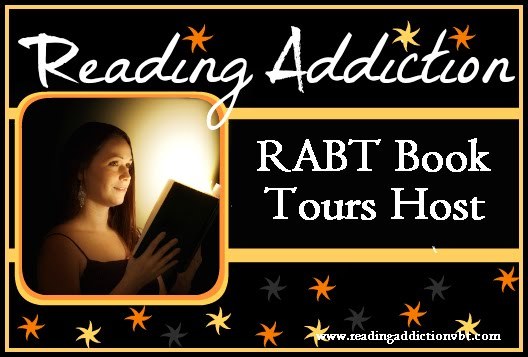
Published on June 26, 2017 23:00
June 22, 2017
The Land Of Merlin ~ Dinas Emrys #FolkloreThursday #Arthurian #Britain #legend
The search for King Arthur continues...
As I said, I am back on with my search for Arthur. Now, I am sure you are aware that Arthur is an elusive King. He is like a phantom or a wisp of smoke. You think you have caught him and then... Nothing. He disappears into thin air.

I could easily run with a theory as to who he was, but I am not going to do that. I want to stick with the legend because thatis what fascinates me. I love folklore. I also love how there always seems to be a ring of truth in it, as I am going to demonstrate today!
Geoffrey of Monmouth and King Arthur
It cannot be disputed that Geoffrey of Monmouth gave us the Arthur we know and love. It is easy to mock his work, but for hundreds of years, Monmouth's Arthur was considered to be factually correct. So for the sake of this post, I am going to pretend that what Monmouth said is historically true — you will see where I am going with this in a minute!
Let's begin...
Merlin
The story of King Arthur does not start, surprisingly, with Arthur. The story begins with Merlin.

It was Merlin that prophesied the coming of Arthur, and it was Merlin and his magic that made sure the rightful king of Britain pulled the sword from the stone. If it had not been for Merlin, there would be no Arthur.
Merlin, it is said, first came to the attention of Vortigern — King of the Britons — when he was a child. Vortigern, in his wisdom, had invited some Saxon mercenaries to Briton to fight with him against the troublesome Picts and Scots. But the problem with Saxon mercenaries is that they couldn't be trusted. Vortigern soon found himself running for his life from the very men he had paid to defend it.
To cut a long story short, Vortigern ended up in Gwynedd, North Wales. More precisely, he ended up on a hill, in which he decided to build a fortress on. Unfortunately, what ever he built, collapsed. Vortigern's magicians told him that he needed to spill the blood of a child without a father, onto the stones. Once he did this, then the fortress would stand.

There was a child, Myrddin Emrys, who seemed a likely candidate. But Emrys was no ordinary child, and he was quite attached to his life and didn't want to die. Nevertheless, he was brought to the usurped King...
"Why have my mother and I been brought into your presence?"
"My magicians have advised me," answered Vortigern, "That I shall look for a fatherless man, so that my building can be sprinkled with blood and thus stand firm."
"Tell your magicians to appear in front of me," answered Merlin, "and I will prove that they have lied."
The History Of The Kings Of Briton.
Emrys challenged the King's magicians and instead gave a plausible reason why the fortress would not stand. He said that two dragons were imprisoned at the bottom of an underground lake beneath the hill. If they set the dragons free, then the foundations of the fort would stand. All they had to do was release the dragons, which they did.
Vortigern built his fort and out of respect, he named the fort after Emrys. He called it Dinas Emrys
But here is where it gets interesting. In 1945 the hill was excavated by archaeologists, and they found an unground lake. So maybe there is a little bit of truth in Monmouth's story after all.

Dians Emrys is now under the care of The National Trust, and they welcome visitors. But walkers are warned to tread softly on the hill, for a dragon sleeps beneath it.
If you fancy finding out what happened after the death of King Arthur then why not check out my historical fantasy series — The Du Lac Chronicles...

Amazon US
Amazon UK
Read for free with

Published on June 22, 2017 00:00
The Coffee Pot Book Club
The Coffee Pot Book Club (formally Myths, Legends, Books, and Coffee Pots) was founded in 2015. Our goal was to create a platform that would help Historical Fiction, Historical Romance and Historical
The Coffee Pot Book Club (formally Myths, Legends, Books, and Coffee Pots) was founded in 2015. Our goal was to create a platform that would help Historical Fiction, Historical Romance and Historical Fantasy authors promote their books and find that sometimes elusive audience. The Coffee Pot Book Club soon became the place for readers to meet new authors (both traditionally published and independently) and discover their fabulous books.
...more
...more
- Mary Anne Yarde's profile
- 159 followers



